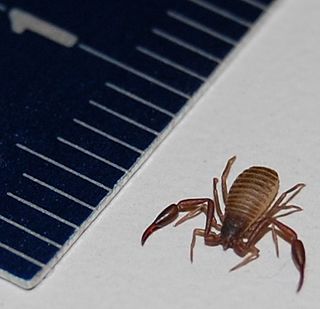
Joseph Conrad Chamberlin was an American arachnologist who studied mainly pseudoscorpions. A native of Utah, he studied primarily at Stanford University while working most of his career in Oregon for the U.S. Department of Agriculture. Several species are named in his honor.

Chthoniidae is a family of pseudoscorpions within the superfamily Chthonioidea. The family contains more than 600 species in about 30 genera. Fossil species are known from Baltic, Dominican, and Burmese amber. Chthoniidae now includes the former families Tridenchthoniidae, and Lechytiidae which has been demoted to subfamilies.

Chernetidae is a family of pseudoscorpions, first described by Anton Menge in 1855.
Horus is a genus of pseudoscorpions in the family Olpiidae, containing the following species:

Garypinidae is a family of pseudoscorpions, first described by Eugen von Daday in 1889.
Dinocheirus is a genus of pseudoscorpions in the family Chernetidae.

Neobisiidae is a family of pseudoscorpions distributed throughout Africa, the Americas and Eurasia and consist of 748 species in 34 genera. Some species live in caves while some are surface-dwelling.

Chthonius is a genus of pseudoscorpions, first described by Carl Ludwig Koch in 1843.

Cheliferidae is a family of pseudoscorpions in the order Pseudoscorpiones, first described by Antoine Risso in 1827.
Hesperochernes is a genus of pseudoscorpions in the family of Chernetidae.
Ideoroncidae is a family of pseudoscorpions belonging to the order Pseudoscorpiones. Members of the family are known from Asia, Africa, western North America and South America.

Withiidae is a family of pseudoscorpions, first described by Joseph Conrad Chamberlin in 1931.
Microcreagris is a genus of pseudoscorpions in the family Neobisiidae. It contains the following species:
Lagynochthonius is a genus of pseudoscorpions in the family Chthoniidae. It was described in 1951 by Austrian arachnologist Max Beier.

Tyrannochthonius is a genus of pseudoscorpions in the family Chthoniidae. It was described in 1929 by American arachnologist Joseph Conrad Chamberlin.
Ideoblothrus is a genus of pseudoscorpions in the Syarinidae family. It was described in 1892 by Italian naturalist Luigi Balzan as a subgenus of Ideobisium.

Geogarypus is a genus of pseudoscorpions in the Geogarypidae family. It was described in 1930 by American arachnologist Joseph Conrad Chamberlin. The genus has a cosmopolitan distribution.
Americhernes is a genus of pseudoscorpions in the Chernetidae family. It was described in 1976 by American arachnologist William Muchmore.
Beierolpium is a genus of pseudoscorpions in the Olpiidae family. It was described in 1976 by French arachnologist Jacqueline Heurtault.









